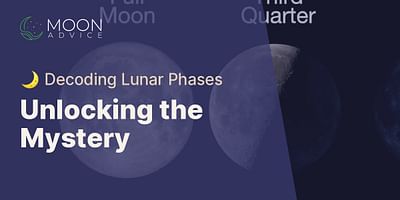Eloise Rowe is a distinguished astrologer, boasting over two decades of professional experience in the domain. Her expertise lies in lunar astrology, where she has devoted her career to unraveling the complex relationship between the moon's cycles and human emotions and interactions. Eloise firmly believes in the guiding power of the moon's phases through life's various highs and lows.
Dear reader,
The moon has captivated humanity since the dawn of time, and ancient civilizations were no exception. Before the discovery of the heliocentric model and our modern understanding of lunar orbit, our ancestors developed fascinating explanations for the phases of the moon. Let's delve into the ancient wisdom surrounding this celestial phenomenon.
Ancient cultures across the globe observed the moon's phases and recognized their significance. They understood that the moon appeared to change shape over time, transitioning from a thin crescent to a full, luminous orb, and back again. These observations led to the development of various beliefs and interpretations.
In ancient times, many cultures believed that the moon was a powerful deity or celestial being. They saw the moon's phases as a reflection of the deity's emotions or energy. For example, during the waxing phase, when the moon grew from a thin crescent to a fuller shape, it was often associated with growth, abundance, and fertility. Conversely, the waning phase, when the moon decreased in size, was linked to release, letting go, and introspection.
Ancient civilizations also connected the moon's phases to the natural cycles of life. They recognized that just as the moon went through its own cycle, so too did the world around them. The waxing and waning of the moon mirrored the ebb and flow of the tides, the growth and decay of plants, and even the rhythms of human emotions.
In addition to these symbolic interpretations, ancient cultures also developed practical uses for understanding the moon's phases. For example, farmers relied on lunar wisdom to determine the best times for planting and harvesting crops. They believed that planting during the waxing phase would yield abundant growth, while harvesting during the waning phase would promote longevity and preservation.
It's important to note that ancient civilizations didn't have the scientific knowledge we possess today. They didn't understand the moon's orbit around the Earth or the interplay between the moon, Earth, and the sun. However, their observations and interpretations laid the foundation for our modern understanding.
As we explore the moon's phases today, we can draw upon this ancient wisdom to deepen our connection with the lunar cycles. By aligning ourselves with the energy of each phase, we can gain insights into our own emotions, relationships, and decisions.
At Moon Advice, we honor the ancient understanding of moon signs and phases. Our articles delve into the rich history of lunar wisdom, exploring the beliefs and practices of ancient civilizations. We invite you to explore our site and discover how the moon's phases can guide you through life's ups and downs.
Remember, the moon's phases are a reminder that life is a cycle of growth, release, and renewal. Embrace the wisdom of the ancients and let the moon be your guide.
Embrace the wisdom of the ancients and let the moon be your guide.
With lunar blessings,
Luna Silverstone















